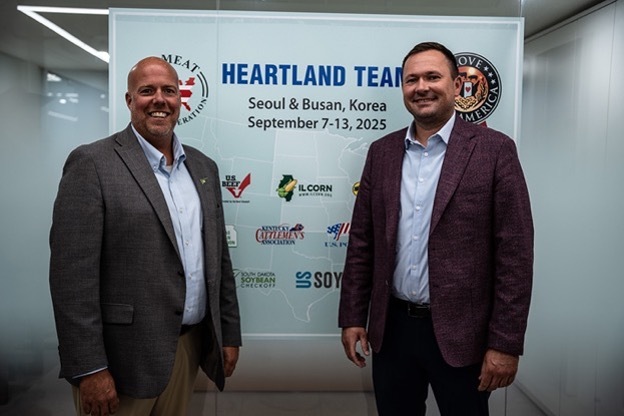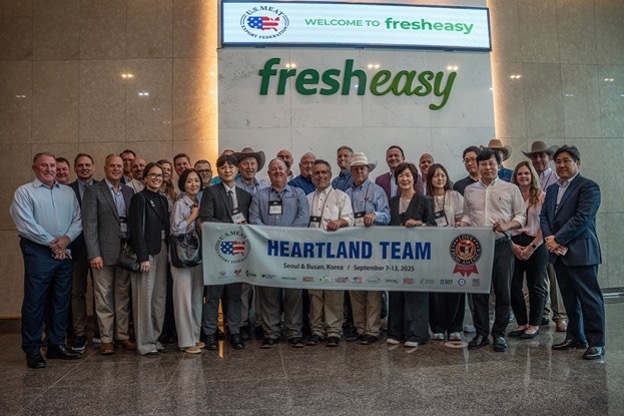Collaboration, Relationships Create Opportunity for Value-Added Soy Products in South Korea

“Collaboration is the key to success for U.S. farmers,” states United Soybean Board Vice Chair and Value Alignment Committee Chair Brent Gatton.
Gatton, together with USB Treasurer Matt Gast, recently traveled to South Korea as part of the U.S. Meat Export Federation’s (USMEF) Heartland Tour. The tour, which aims to further demand for U.S. beef and pork, took place Sept. 7 – 13 and included 19 other farmers and ranchers representing livestock and row crop organizations.
The mission visited a variety of retailers, including Costco, E-Mart and Coupang, popularly referred to as the “Amazon of South Korea,” focusing on growing protein-based diets in the country. The group also held meetings with importers Fresheasy, Frank Burger, and Highland Foods, and administrators at the Port of Busan. Additionally, they spoke with trade officials at the U.S. Embassy in Seoul, discussing sustainability practices, opportunities, and issues.
USB currently invests $2.2 million in USMEF. This investment is important, says Gatton. because it helps U.S. soybean farmers to get their product into international markets. “USMEF is doing great work around the world. In Korea specifically,” he explains, “that means that USMEF is helping us to get soy into the Korean market, primarily as a value-added product in meat.”
Gast says that although Korea’s population is just 51.75 million1 and roughly the size of the state of Indiana2, the country presents a growing opportunity for soybean farmers.
And American beef and pork are leading the way.
“In 2024,” says Gast, “Korea purchased more U.S. beef than any other export market at $2.2 billion in sales, while U.S. pork exports reached a record $728 million.”3 “And through July 2025, they have purchased about $1.4 billion in U.S. beef, up nine percent from last year, and $432 million in U.S. pork.”4
Korean dynamics are shifting as demand for protein grows, Gast says. “Many people I spoke with said they now eat protein at every meal.” He learned that the population is eating less rice and more protein.
While beef remains the biggest opportunity for U.S. farmers, soybean meal is another bright prospect.
While meal sales represent an opportunity for soybean farmers, Gast says the Korean livestock sector does face some limitations. First, mountains and hills make up about 70% of the country,5 limiting space. The Korean population is so dense that Gast likens it to more than 50 million people living in a corner of Indiana. “They will probably also continue to import our meat simply because they prefer it, while also importing some meal,” he says.
Although imported American meat is expensive, Koreans’ appetite for it only continues to grow. “They do produce Wagyu there,” Gast says, “but the quality is not the same as ours. They also import meat from Australia but still prefer meat from the U.S.” Steakhouses serving U.S. beef are cropping up across the country, he notes. “We also saw quite a few banners advertising U.S. beef, pork, soy, and USMEF,” he reports. “These were not placed there because of our visit but were a regular, everyday thing.”
In fact, Koreans’ penchant for U.S. beef and pork is so great that USMEF established American BBQ week, where U.S. meat products are promoted in restaurants across the country. This year, USMEF built on the success of previous American barbecue promotions in Korea, implementing the event in Seoul, Inchon, and Busan. Nineteen outlets from 12 American barbecue restaurants participated in three, week-long promotions that featured dishes made with U.S. beef and pork. The showcase allows consumers to enjoy a special barbecue gourmet experience at a discounted price.
Gatton says that meat exports help to drive domestic demand for U.S. Soy in animal diets. USMEF and other export organizations also help to get other U.S. soybean products such as oil and whole beans into international markets wherever possible.
“USB’s board invested about $28 million into our overall export package this year,” Gatton states. “We are putting money into demand drivers and initiatives, aiming to provide immediate help to the market through exports and organizations like USMEF help to drive this.”
USMEF’s showcasing of U.S. meat products helps to drive brand recognition and opportunities, while keeping relationships front and center.
Overall, says Gast, the opportunity to meet with buyers and emphasize the quality and sustainability of U.S. products is critical. “We already know that our Korean customers prefer U.S. beef and pork, so telling them about how we as farmers grow more with less helps to further solidify their preference for our products. Whether we produce beef, pork, or soy – and, of course, soy is an important component of these meats – strengthening these relationships is vital.”

United Soybean Board Vice Chair Brent Gatton and Treasurer Matt Gast joined the U.S. Meat Export Federation’s Heartland Team in South Korea to strengthen relationships and highlight soy’s role in supporting global protein markets.

United Soybean Board Vice Chair Brent Gatton and Treasurer Matt Gast joined the U.S. Meat Export Federation’s Heartland Team in Seoul and Busan, South Korea, to strengthen trade relationships and highlight soy’s key role in global protein markets. Collaboration continues to open doors for value-added U.S. Soy products.
1 https://www.statista.com/topics/5931/demographics-of-south-korea/#topicOverview
3 https://usmef.org/news/heartland-team-sees-demand-drivers-for-u-s-beef-and-pork-in-korea
